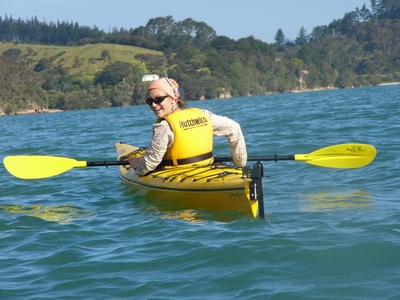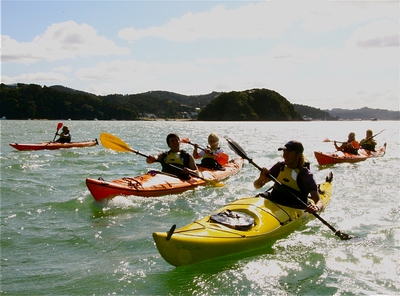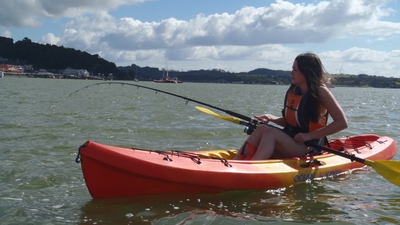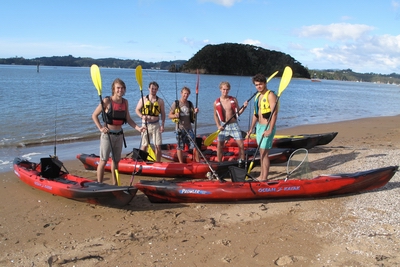Providing kayaks for hire or reward: Guidelines and advice

Kayaking is a popular pastime for many New Zealanders and overseas visitors. If you or your business rents (hires) or provides kayaks as part of an accommodation package (reward), you have responsibilities to consider as well as the safety guidelines covered in the Northland Regional Council publication Kayak safety guidelines.
If you are offering or providing a kayak as part of your service, or specifically for hire, then you are responsible for the safety of the people going out on the water.
As a minimum, you need to provide safety equipment, safety advice, and clear instructions on the areas and limits of operation of the kayaks. Other factors such as current weather conditions, the weather forecast, and the experience of the people hiring or borrowing your equipment, will need to be taken into account.
Remember, if there is an accident, the authorities will take a dim view if you cannot show that you have taken these responsibilities seriously.

Guidelines for anyone providing kayaks for hire or reward:
- Be sure the equipment provided is in a sound and safe condition.
- Check the current weather conditions and forecast weather and sea conditions. If offshore winds are forecast, winds are due to increase or a weather front is forecast, you should advise anyone wishing to hire or use a kayak to stay onshore and wait for calmer weather.
- Discuss the operational area for the kayak. Point out places to visit considering the current conditions and emphasising any limits (for example, don't go past this point…). Also, take into account any areas to be avoided (for example, commercial wharfs, shipping channels, and ski lanes). The current Northland Navigation Safety Bylaw 2012 covers the areas to be avoided (you can access a copy online at www.nrc.govt.nz/onthewater).
- Talk safety. Do they have a form of communication? What happens if they capsize? Do they need basic instruction on how to use the kayak? What are their experience levels?
- Discuss with kayakers how long they plan to be out and who to inform on their return.
- Discuss what your actions will be if they are not back at the specified time, for example, that you will inform the Police and/or Coastguard. When it comes to return time, a good guide for anyone hiring or using a kayak is to plan to be back well before sunset.

Remember: safety equipment and safety information must be provided by you as the person or company receiving hire or reward for the use of the kayak.
Do they understand?
Have the people hiring the kayak understood what is being said? If the people going out do not speak English, and have not fully understood your instructions, then there is potential for more problems if they get into trouble.
Plans
There are a number of plans you should have in place and discuss, when providing a kayak for hire or reward:
- A plan to retrieve your equipment should they capsize and the person swims to shore without the kayak.
- What the hirer should do if they are drifting in the currents and can't re-enter the kayak.
- Do you know the relevant numbers to call for assistance (Police / Coastguard) if this situation comes to your attention?
- Who has a boat nearby to assist with support if you don't own one?
Remember: you have a responsibility to assist if people are in trouble while using your equipment.
Before letting people go on the water with your kayak, be sure you have ticked off a checklist like the one below:
| Kayaks and equipment are in sound condition. | |
| Weather forecast and tide (if applicable) information has been checked. | |
| Safety briefing including what to do if they capsize (wet exit), techniques for getting back in or on the kayak, or if conditions deteriorate, advise them to paddle to shore immediately. | |
| After the safety briefing, be sure you are confident their abilities are at a good enough standard to stay safe on the water, if not you should advise them this activity may not be for them. | |
| Are they visible enough? | |
| Supply an appropriate lifejacket and check they know how to wear it properly. | |
| Have they been instructed that the lifejacket should be kept on and not removed? | |
| Do they have adequate clothing, water and food to match the planned journey? | |
| Have area limits been agreed on? | |
| Do they have a waterproof form of communication (for example, mobile phone in a dry bag or VHF radio)? | |
| Dangers have been pointed out and areas to be avoided (commercial wharves, shipping lanes, ski lanes etc). | |
| Time and place of departure and time of return (for example, before sunset) have been agreed. Who they should contact when they return? | |
| Discuss what action will occur if they are late from their planned return time, for example, police and coastguard informed. |
Don't forget to
- Reinforce sticking together (pod) when kayaking with a group.
- Always keep a good look out for other water users.
- Be considerate to marine and bird life.
- Be tidy and take rubbish with you.
Remember: if you are not comfortable with this responsibility, then send people in the direction of a professional kayak company. There will be one near you.
If in doubt, don't send them out!

